Passing through the lines
This is a training session that incorporates quick combination passing, positional awareness and intelligent decision-making. It’s important to practise this because receiving and passing are core skills, and they are fundamental to the success of every football team.

| Area | 36x12 yards |
| Equipment | Balls, bibs, mannequins (or cones) |
| No. of Players | Up to 12 players |
| Session Time | Warm-up: 15mins, Section games: 2x15mins, Full-size game: 16mins |
This is a training session that incorporates quick combination passing, positional awareness and intelligent decision-making.
It’s important to practise this because receiving and passing are core skills, and they are fundamental to the success of every football team.
Preparation is essential, as is practising what we play and how we play. Players must have seen the situation before it occurs – in this instance, that means always looking up before passing and receiving.
The ability to perfect this offers rewards in all areas of the pitch. So that could be the quick passing from defence into midfield, or precise link-up play into front players.
The session is realistic to game situations; we find that making training challenging helps players work out situations quickly.
What do I get the players to do?
Rotation warm-up
We begin the session with a rotation warm-up in a 36x12-yard area divided into three equal 12x12-yard boxes, with scattered mannequins or cones offering fixed obstacles.
A player waits in the middle box, with non-working players in lines at either end. All players follow their passes.
A player at the bottom dribbles the ball a few yards into the area before passing to the man in middle box. The receiver takes the ball on the turn, runs, and passes to the incoming player at the top, before sprinting out to join the queue in front of him, as shown [1]. The practice then comes back in the opposite direction and the process is repeated. To develop, can any player receiving the ball move it on with one touch?
1
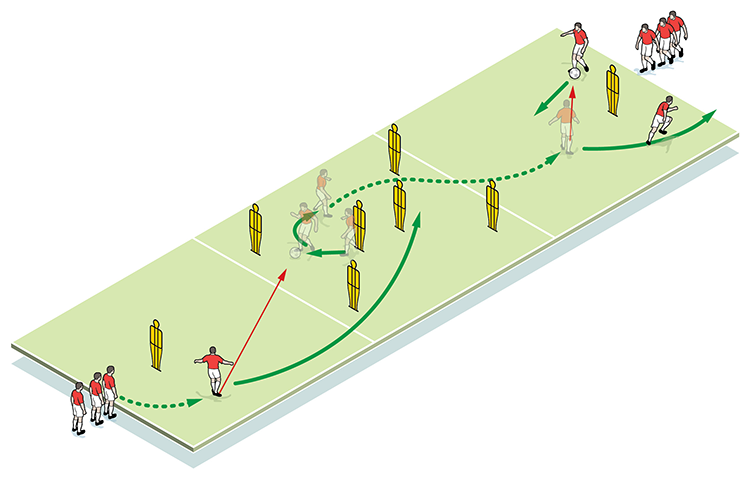
Passing game
For the next part we divide the players into three equal groups. Each group must remain in their box at all times, and each individual player in a specified area of the box – top left, top right, bottom left or bottom right.
The reds in the right-hand box combine (with a three-touch minimum rule) before sending a pass through the blues to the other group of reds, as shown [2a]. Then a new combination starts [2b], and if the ball makes it back to the right-hand box a point is awarded. If blues intercept, they score a point and play to the opposite four reds, then the game resets.
2a
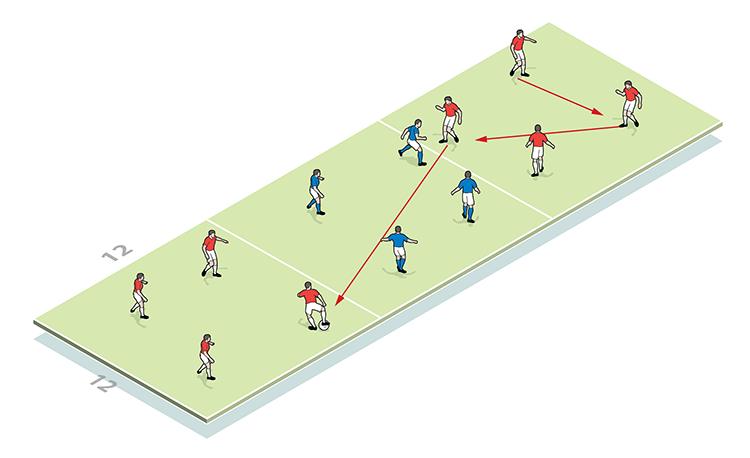
2b
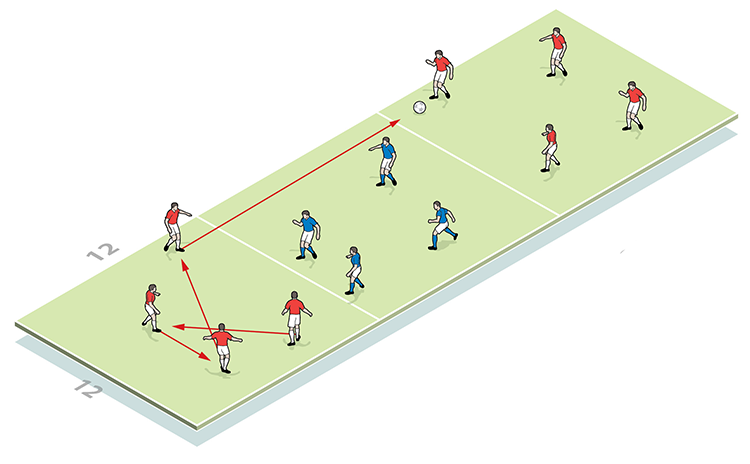
Rotating players within boxes, each group defends for four minutes with a 90-second recovery in between. To progress, we remove the three-touch condition to test players’ decision-making, and change player numbers or area size to vary the level of difficulty, as shown [3].
3
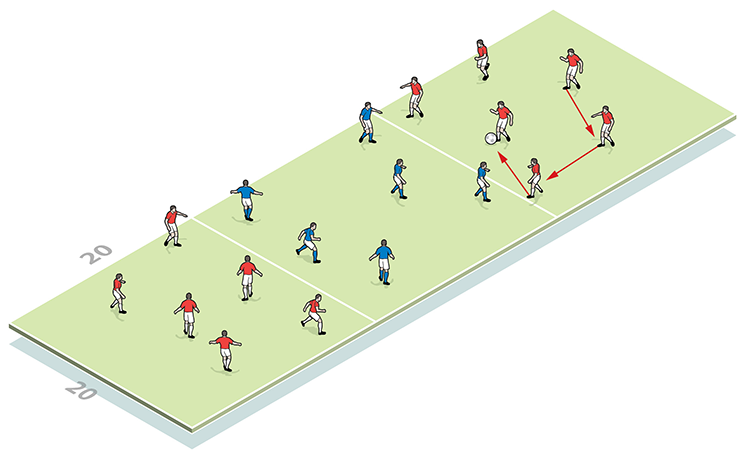
Movement game
Next we set up for an 8v4 game in the same three 12x12-yard boxes, as shown [4a]. The top box is an opposed 4v2 in favour of the reds, with a 3v2 in the middle, also in favour of the reds, and a lone red at the bottom. Players cannot move out of their boxes until the ball is transferred from one end to the other through each box.
4a
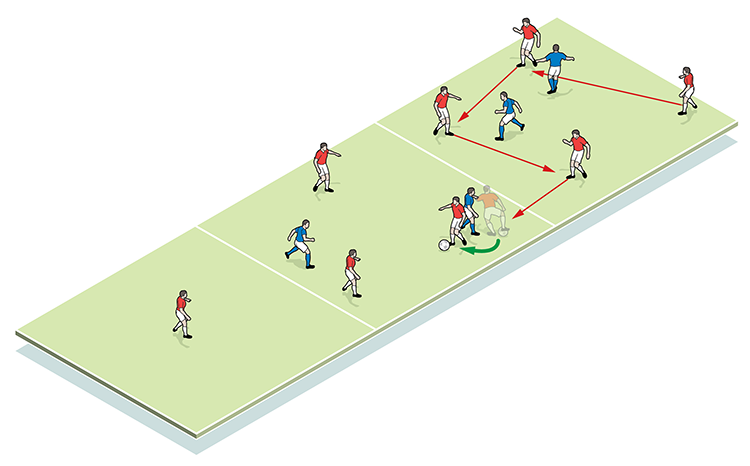
Once the transfer is made though, the middle box players can follow the ball to make a new 4v2 at the bottom [4b]. And from the top box, three reds and two blues move down, leaving only a solitary red. Play now switches back in the opposite direction, as shown [4c]. The game is played in phases of four minutes, but scored so that if the blue defenders win the ball they transfer it to the lone player, something that incorporates movement up and down the pitch.
4b
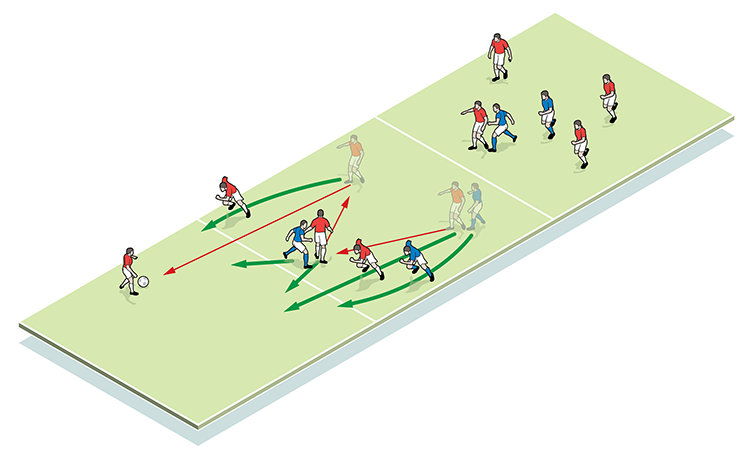
4c
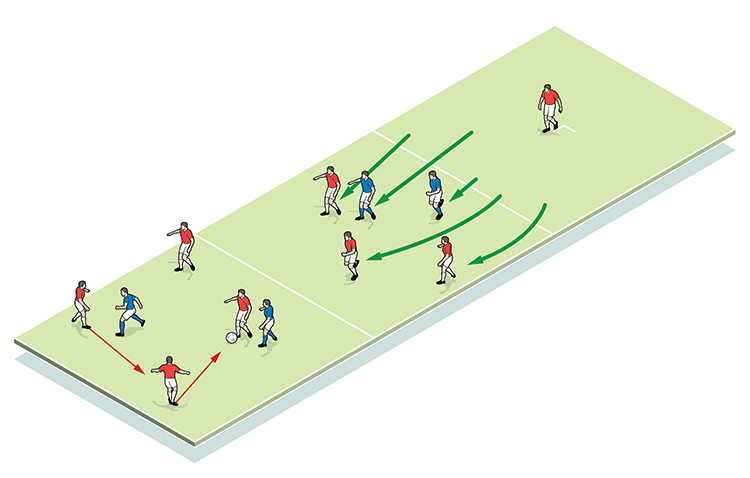
What are the key things to look for?
We’re looking for success before introducing a new challenge. If players have been successful, we might reduce the playing area to increase difficulty. If players have not been successful, we will initially increase the size of the playing area to decrease difficulty, then return to the original dimensions when they have mastered the routine.
Throughout, players must be alert in receiving and passing. The ball needs to be moved quickly and positively, particularly during the movement game. Looking up and assessing opposition threat is a key quality for attackers and defenders, while the latter need to work both individually and collectively to counter the threat.
How do I put this into a game situation?
For a full-size game, we divide a pitch into thirds and encourage passing through sections, as rehearsed in the session. In forward moves, we look for slick one-touch and combination play that leads into and out of side-on passing.
Editor's Picks
Attacking transitions
Deep runs in the final third
Using the goalkeeper in build-up play
Intensive boxes drill with goals
Penetrating the final third
Creating and finishing
My philosophy
Pressing initiation
Compact team movement
Coaches' Testimonials

Alan Pardew

Arsène Wenger

Brendan Rodgers

Carlos Carvalhal

José Mourinho

Jürgen Klopp

Pep Guardiola

Roy Hodgson

Sir Alex Ferguson

Steven Gerrard
Coaches' Testimonials

Gerald Kearney, Downtown Las Vegas Soccer Club

Paul Butler, Florida, USA

Rick Shields, Springboro, USA

Tony Green, Pierrefonds Titans, Quebec, Canada
Join the world's leading coaches and managers and discover for yourself one of the best kept secrets in coaching. No other training tool on the planet is written or read by the calibre of names you’ll find in Elite Soccer.
In a recent survey 92% of subscribers said Elite Soccer makes them more confident, 89% said it makes them a more effective coach and 91% said it makes them more inspired.
Get Monthly Inspiration
All the latest techniques and approaches
Since 2010 Elite Soccer has given subscribers exclusive insight into the training ground practices of the world’s best coaches. Published in partnership with the League Managers Association we have unparalleled access to the leading lights in the English leagues, as well as a host of international managers.
Elite Soccer exclusively features sessions written by the coaches themselves. There are no observed sessions and no sessions “in the style of”, just first-hand advice delivered direct to you from the coach.









